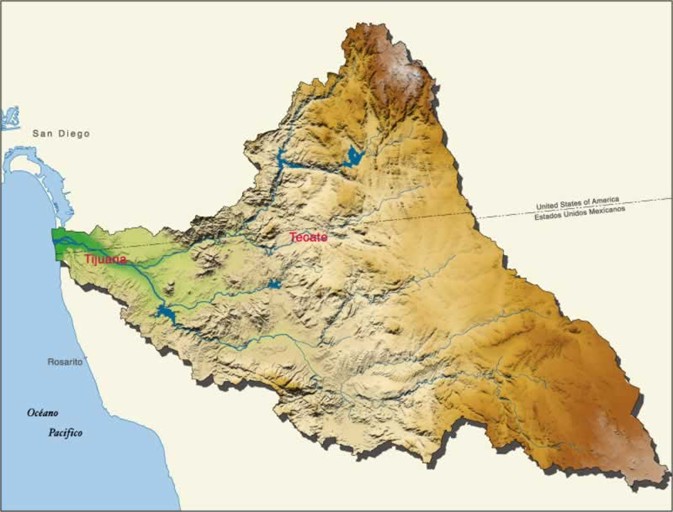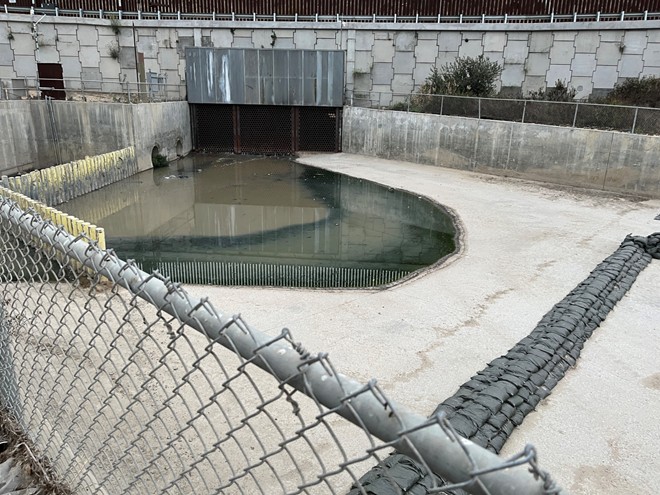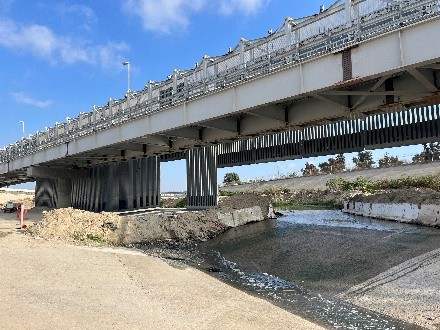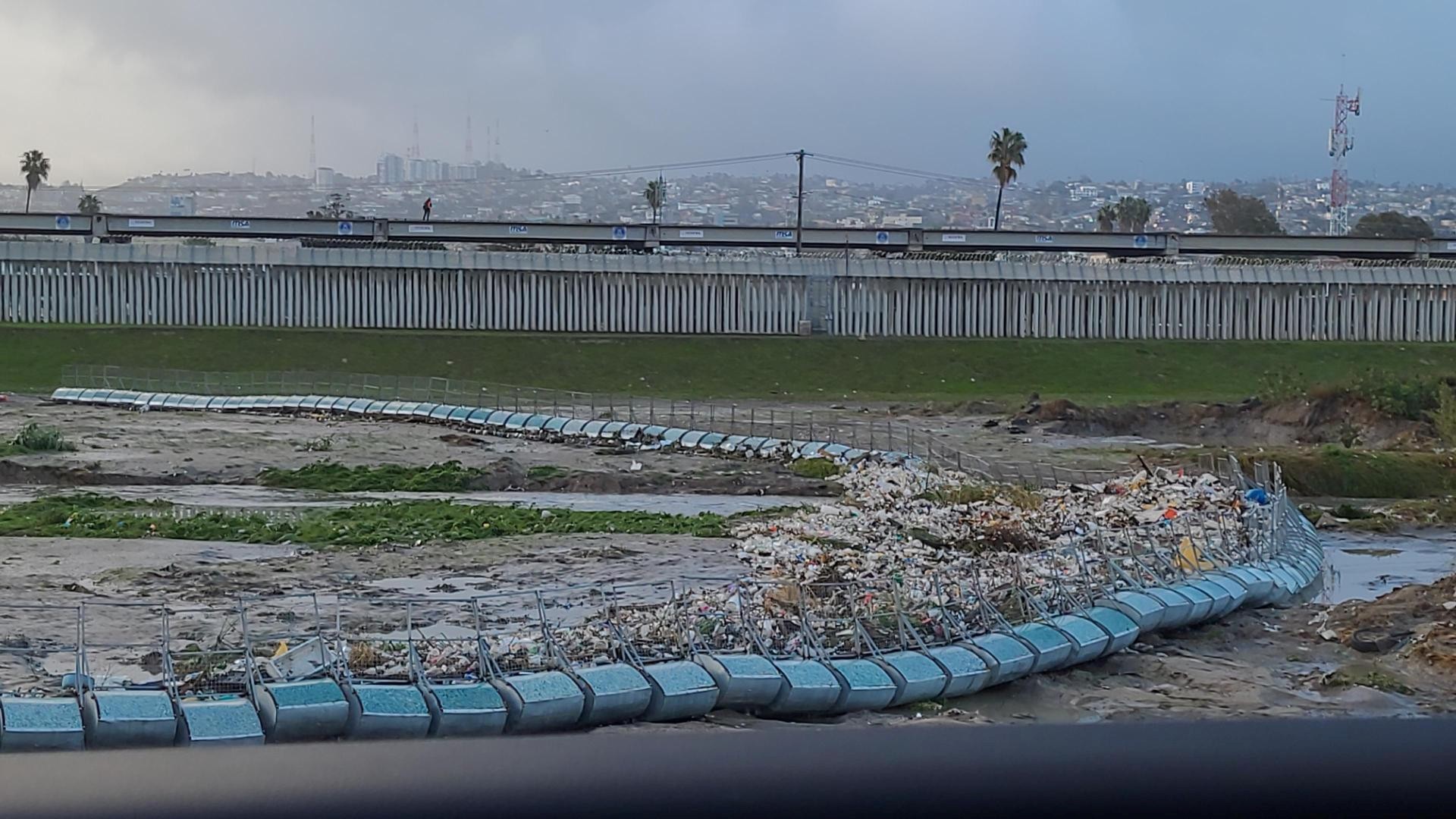U.S-Mexico Border Water Quality




- On August 27, 2025 the California Regional Water Quality Control Board, San Diego Region (San Diego Water Board) issued Cease and Desist Order No. R9-2025-0139 to the United States section of the International Boundary and Water Commission (USIBWC), South Bay International Wastewater Treatment Plant (SBIWTP), Discharge to the Pacific Ocean through the South Bay Ocean Outfall.
- On August 13, USIBWC Commissioner McIntosh provided an informational update during the San Diego Water Board’s regularly scheduled meeting on the status and progress of SBIWTP upgrades and other infrastructure improvements to prevent pollution from Mexico from entering the San Diego Region.
- On July 24, USIBWC announced the signing of a “Memorandum of Understanding [MOU] between the United Mexican States [Mexico] and the United States of America on Addressing the Sanitation and Environmental Crisis in the Tijuana – San Diego Region.” According to the USIBWC press release, the MOU outlines specific actions the United States and Mexico will take to implement a permanent 100 percent solution to end the transboundary flow crisis. The MOU includes provisions for 1) expedited timelines for the completion of Minute 328 projects no later than December 31, 2027; 2) the release of United States Environmental Protection Agency (USEPA) Border Water Infrastructure Program funding to complete the rehabilitation of Pump Station 1 and Tijuana River collection pipes; 3) Mexican funding and construction for 10 MGD of treated effluent diversion and reuse from two wastewater treatment plants in Tijuana and the rehabilitation of a critical wastewater conveyance line in Tijuana no later than December 31, 2025; 4) Mexican allocation of funding to complete remaining Minute 328 projects; 5) the accelerated interim 10 MGD expansion of the SBIWTP; and 6) a new treaty Minute to accomplish a permanent, long-term, durable 100 percent solution to transboundary flows of untreated wastewater from Tijuana. The full MOU is posted on USEPA’s website.
- On July 22, USIBWC was alerted to construction on a wastewater conveyance line “Colector Oriente” in Tijuana’s Zona Río, which began on or about July 21. USIBWC reports that Tijuana’s State Public Utilities Commission (CESPT) is discharging 4 million gallons per day (MGD) to the main channel of the Tijuana River and plans to continue this discharge until the project is completed in October. While this discharge is located upstream of pump station PB-CILA, which diverts dry-weather river flows to the Mexican coast, the discharge is expected to result in additional transboundary flows, as pump station PB-CILA is already operating at full capacity.
- On July 21, the Scripps Institution of Oceanography hosted a webinar to introduce Phase 1 of a Pathogen Forecast Model developed by scientists from UC San Diego (UCSD). This model includes an online, five-day prediction of ocean sewage and swimming-related illness risk for beaches in the San Diego and Tijuana border region, from Coronado to Playas de Tijuana. The Pathogen Forecast Model web interface is available on UCSD’s website.
- On June 12, the USIBWC San Diego Citizens Forum board hosted an in-person and virtual meeting to discuss the accelerated expansion of the SBIWTP. The meeting agenda, presentation, and recording are posted on USIBWC’s website.
- On June 10, the Agency for Toxic Substances and Disease Registry (ATSDR) shared the following fact sheet outlining their effort to evaluate potential health risks in the Tijuana River Valley.
- ATSDR Fact Sheet (English) For a copy of this document, please email a request to our records administrator at rb9_records@waterboards.ca.gov.
- ATSDR Fact Sheet (Español) For a copy of this document, please email a request to our records administrator at rb9_records@waterboards.ca.gov.
- Sign up to receive email updates from ATSDR by contacting Ben Gerhardstein (bgerhardstein@cdc.gov) in the ATSDR Region 9 office.
- ATSDR Fact Sheet (English) For a copy of this document, please email a request to our records administrator at rb9_records@waterboards.ca.gov.
- On May 28, the peer-reviewed multidisciplinary scientific journal Science Advances published a study examining the impacts of transboundary pollution in the Tijuana River and near shore waters on coastal aerosols. The study finds that wastewater compounds become aerosolized and are detectable in both water and air. The full study is available on Science Advances’ website: https://www.science.org/doi/10.1126/sciadv.ads9476
- On May 21, USIBWC reported that the second and final phase of work on the International Collector in Tijuana was completed. While the initial plan for Phase 2 involved a three-to-five-day outage at the SBIWTP, authorities in Mexico were able to bring in temporary pumps to continue supplying the SBIWTP with influent during Phase 2. USIBWC reports that this bypass prevented 75 million gallons of wastewater from entering the Tijuana River during Phase 2. Rehabilitation of the International Collector is a key project to improve resiliency of the Tijuana wastewater collection system.
- On May 20, USIBWC issued a press release announcing a planned acceleration of the incremental expansion of the SBIWTP from 25 to 35 million gallons per day (MGD). Please view the press release for more details: https://www.ibwc.gov/wp-content/uploads/2025/05/SBIWTP-Fast-Track-Expansion-05-19-25_Final.pdf
- Construction of a new wastewater treatment plant at San Antonio de los Buenos in Mexico was completed on January 31. Operations were formally handed over from the Mexican Secretariate of National Defense (SEDENA) to Tijuana’s State Public Services Commission (CESPT) in late-May 2025. La Jornada Baja California has posted a video outlining the details of the San Antonio de los Buenos Wastewater Treatment Plant (subtitles in English): https://youtu.be/oriEa8w9Eqs?si=uIz2GReiogytVzJ4
- On March 13 USEPA formally accepted the Lower Tijuana River Indicator Bacteria and Trash Advance Restoration Plan (ARP). USEPA acknowledges that the ARP fulfills California’s obligation under the Clean Water Act’s 303(d) Program to develop a plan to restore water quality in the lower Tijuana River. For more details, please visit the ARP’s website.
- Non-profits Alter Terra and Rural Community Assistance Corporation (RCAC), have reported that the Tijuana River Trash Boom is functioning as expected, intercepting trash generated in Mexico, and preventing it from reaching the Tijuana River Estuary and Pacific Ocean. This $4.7 million pilot project was funded by the State Water Resources Control Board to study the most effective mechanism for trash interception and disposal and to inform a more permanent solution in accordance with Project J in the June 2023 USIBWC-USEPA Joint Record of Decision for the Final Programmatic Environmental Impact Statement for the United States-Mexico-Canada Agreement Mitigation of Contaminated Transboundary Flows Project.
- On February 18, the San Diego Water Board issued Investigative Order No. R9-2025-0022 to USIBWC. The investigative order requires USIBWC to submit technical information related to discharges of waste from multi-day Spill Events at the Hollister Street Pump Station and at the Goat Canyon and Smuggler’s Gulch canyon collectors.
- The SBIWTP continues to be in compliance with secondary treatment effluent limitations. On February 10, San Diego Water Board staff conducted the annual compliance evaluation inspection of the SBIWTP. No new violations were identified.
- On June 10, the Agency for Toxic Substances and Disease Registry (ATSDR) shared the following fact sheet outlining their effort to evaluate potential health risks in the Tijuana River Valley.
- ATSDR Fact Sheet (English)
- ATSDR Fact Sheet (Español)
- Sign up to receive email updates from ATSDR by contacting Ben Gerhardstein (bgerhardstein@cdc.gov) in the ATSDR Region 9 office.
- Centers for Disease Control and Prevention (CDC) and County of San Diego Community Assessment for Public Health Emergency Response (CASPER)
- CDC, Agency for Toxic Substances and Disease Registry (ATSDR), and County of San Diego ATSDR Exposures Survey (ACE)
- SDSU School of Public Health “Healthy Water, Healthy Air” Community Survey
USEPA conducted a preliminary evaluation of the Lower Tijuana River Valley for eligibility to be added to the National Priorities List (NPL) under the Comprehensive Environmental Response, Compensation and Liability Act (CERCLA), also known as Superfund. This was in response to an October 24, 2024, petition from local elected officials to investigate the Tijuana River Valley for Superfund designation with the goal of obtaining federal resources to clean up hazardous substances and protect the health of people and sensitive environments.
On January 3, 2025, USEPA responded that further evaluation of the Tijuana River Valley was not warranted, in part, because contaminants detected in water and sediment samples do not exceed USEPA’s screening levels for protection of human health.
Transboundary flows in the main channel of the Tijuana River and those that bypass canyon collectors in the Tijuana River Valley severely impact areas in and around Border Field State Park and the Tijuana River National Estuarine Research Reserve, including closure of access to Border Field State Park, invasive plant infestations, significant increases in mosquito populations, critically low dissolved oxygen levels in the Tijuana River Estuary, and reduced fish species and overall presence of fish.
The U.S. International Boundary and Water Commission (USIBWC) collection and treatment facility consists of the following:
- South Bay International Wastewater Treatment Plant (SBIWTP)
- Five diversion structures (also referred to as canyon collectors) located at:
- Stewart's Drain
- Silva Drain
- Canyon del Sol
- Smuggler's Gulch
- Goat Canyon
- Two Pump stations:
- Hollister Street Pump Station
- Goat Canyon Pump Station
- Two junction boxes:
- Junction Box 1
- Junction Box 2
- South Bay Land Outfall
- South Bay Ocean Outfall
- Other associated infrastructure, such as the pipes and conveyances between the diversion structures, pump stations, and the wastewater treatment plant.
Together, these comprise a federally-owned treatment works and are collectively referred to as the Facility.
In November 2024, the SBIWTP regained compliance with secondary treatment standards.
The SBIWTP may receive domestic and industrial wastewater from the following sources:
- City of Tijuana’s municipal collection system;
- Five canyon collectors: Stewart’s Drain, Canyon del Sol, Silva Drain, Smuggler’s Gulch, and Goat Canyon; and
- Transboundary flows from other locations collected by vacuum trucks.
SBIWTP influent is unlike influent at other wastewater treatment plants because the SBIWTP receives wastewater, sediment, and debris from a collection system in Mexico that USIBWC does not control. Lack of control over influent quality and flow rates puts the SBIWTP in a vulnerable state, necessitating ongoing corrective maintenance.
At this time, there is no reliable way for USIBWC to control influent flow to the SBIWTP so that it does not exceed its permitted limit of 25 MGD (monthly average). During dry weather, the permitted limit is not generally exceeded. However, inflow and infiltration (I&I) to Tijuana’s sewage collection system during wet weather increases influent flows to the SBIWTP.
The purpose of Junction Box 1 (JB1), just north of the international border and upstream of the SBIWTP, is to control influent flow to the SBIWTP. However, JB1’s 72-inch gate valve that connects to Tijuana’s sewage collection system and 96-inch gate valve that connects to Junction Box 2 (JB2), which feeds the SBIWTP, are both inoperable. The 72-inch gate valve became inoperable on August 28, 2019. The 96-inch gate valve became inoperable on October 3, 2020.
USIBWC previously estimated that a new junction box would be installed by February 10, 2025. However, the schedule has been delayed due to changes in design and long lead times for receiving construction material. On September 30, 2024, USIBWC hosted a groundbreaking ceremony for the replacement of JB1. USIBWC now estimates that the new JB1 will be installed by August 31, 2025.
The Facility is regulated under San Diego Water Board Order No. R9-2021-0001 as amended by Order No. R9-2023-0009, National Pollutant Discharge Elimination System No. CA0108928, Waste Discharge Requirements for the United States Section of the International Boundary and Water Commission South Bay International Wastewater Treatment Plant Discharge to the Pacific Ocean Through the South Bay Ocean Outfall (Order). The Order and reports required by the Order are available on the California Integrated Water Quality System Project (CIWQS) web page.
In August 2024, USIBWC awarded a contract for a SBIWTP rehabilitation and expansion project. USIBWC anticipates design for the SBIWTP rehabilitation and expansion project to be completed by May 2026. The maximum timeline for construction is five years. The contractor expects to decrease this timeline by as much as 18 months through a progressive design-build approach. The plant will remain in operation throughout design and construction. The project includes essential rehabilitation of existing infrastructure and capacity expansion to double current treatment capacity of 25 MGD to reach 50 MGD average flow, with a peak hydraulic flow capacity of 75 MGD.
The July 2022 Minute 328 of the 1944 U.S.-Mexico treaty entitled Utilization of the Colorado and Tijuana Rivers and of the Rio Grande (1944 Water Treaty) and the USIBWC-U.S. Environmental Protection Agency (USEPA) June 2023 Joint Record of Decision (ROD) for the United States-Mexico Canada Agreement (USMCA) Mitigation of Contaminated Transboundary Flows Project both include the SBIWTP rehabilitation and expansion project, but the minute and ROD have different roles. Minute 328 is the agreement between Mexico and the U.S. that includes project responsibilities, such as operation and maintenance (O&M) and cost sharing. The ROD is what enables USEPA and USIBWC to proceed to the design phase for proposed projects.
- Minute 320
The October 2020 International Boundary and Water Commission (IBWC) Minute 320 of the 1944 U.S.-Mexico treaty entitled Utilization of the Colorado and Tijuana Rivers and of the Rio Grande (1944 Water Treaty) establishes a framework of binational collaboration to address trash, sediment, and water quality issues in the Tijuana River Watershed. IBWC leads a Minute 320 binational core group and binational workgroups represented various stakeholder agencies, non-governmental organizations, and academia. These groups work to advance binational coordination/collaboration and projects to improve water quality and reduce trash and sediment loading in the Tijuana River Valley.
- Minute 328
The July 2022 IBWC Minute 328 of the 1944 Water Treaty is an international agreement between Mexico and the U.S. that outlines 18 projects planned for 2022-2027 as well as seven potential projects for the unspecified future. The projects in Mexico include improvements to Tijuana’s wastewater collection and treatment systems to better manage wastewater and eventually reuse treated wastewater. Completion of this suite of infrastructure projects will provide benefit on both sides of the border, including reductions in wastewater in the Tijuana River Valley and Pacific Ocean. The public can access the U.S. International Boundary and Water Commission (USIBWC) Geographic Information System (GIS) web portal to view the location, description, and status of projects included in Minute 328.
- USMCA Mitigation of Contaminated Transboundary Flows Project
The June 2023 USIBWC-USEPA Joint Record of Decision (ROD) for the United States-Mexico-Canada Agreement (USMCA) Mitigation of Contaminated Transboundary Flows Project contains ten proposed projects in Mexico and the U.S. aimed at reducing transboundary water pollution; four core project and six supplemental projects. The four core projects underwent a detailed analysis in the November 2022 USEPA-USIBWC USMCA Programmatic Environmental Impact Statement (PEIS). The six supplemental projects are still early in their planning phase and were not yet ready for detailed environmental review in the PEIS. To date, funding has not been identified for most of the ROD projects. Without full implementation of the projects needed to control transboundary flows, polluted water and trash are likely to continue to impact the Tijuana River Valley, Tijuana River Estuary, and coastal waters from the international border to the City of Coronado.
Several of the projects specified in the ROD are the same as, or similar to, those included in Minute 328, but the minute and ROD have different roles. Minute 328 is the agreement between the two countries that includes project responsibilities, such as operation and maintenance (O&M) and cost sharing. The ROD is what enables USEPA and USIBWC to proceed to the design phase for proposed projects. Section 2.8 of the PEIS includes a comparison of USMCA and Minute 328 projects.
Three projects in the Tijuana River Valley were funded by Senate Bill 170 through the State Water Resources Control Board Division of Financial Assistance:
- Tijuana River Flood Control Trash Control Structure ($4.73 million – Rural Community Assistance Center)
- Smuggler’s Gulch Dredging Project ($4.25 million – County of San Diego)
- Tijuana River Valley Hydrology and Habitat Restoration ($2 million – County of San Diego)
Each of the three projects are deeply rooted in the 13 years of coordinated federal, State of California, local agency, and non-governmental organization efforts in the Tijuana River Valley Recovery Team to restore and protect water quality. They were originally proposed in the 2012 Tijuana River Valley Recovery Strategy: Living with the Water and refined and analyzed in the 2020 Tijuana River Needs and Opportunities Assessment Report.
The Tijuana River trash control structure project involves the design, construction, operation, and maintenance of a floating trash boom system for one storm season in the main channel of the river, immediately downstream of the international border. The Rural Community Assistance Center deployed the trash boom system and hosted a ribbon cutting ceremony on December 17, 2024. This is a demonstration project. The information gathered will be used to develop permanent trash control infrastructure (Project J of the June 2023 U.S. International Boundary and Water Commission-U.S. Environmental Protection Agency [USIBWC-USEPA] Joint Record of Decision (ROD) for the United States-Mexico-Canada Agreement (USMCA) Mitigation of Contaminated Transboundary Flows Project).
The Smuggler’s Gulch dredging project involved the removal of approximately 30,000 cubic yards of accumulated sediment, trash, and debris in Smuggler’s Gulch and the Tijuana River Pilot Channel. The accumulated sediment, trash, and debris contributed to flooding, which threatens public and private properties and critical habitats. In March 2024, the County of San Diego initiated trash and sediment removal activities, which concluded in late 2024. This dredging is necessary prior to installation of permanent sediment and trash capture infrastructure at Smuggler’s Gulch, which will be funded by a separate grant.
The Tijuana River Valley hydrology and habitat restoration project consists of remediating a contaminated seven-acre property adjacent to the Tijuana River and restoring it to native upland coastal sage scrub habitat. Demolition of on-site structures, soil preparation, irrigation installation, and planting are complete. Habitat restoration is underway with successful natural recruitment and minimal non-native plant species present.
Proposition 4, which includes $50 million for border river pollution grants, was approved by California voters in November 2024. Funding will start in Fiscal Year 25-26.
The U.S. International Boundary and Water Commission (USIBWC) owns the South Bay International Wastewater Treatment Plant (SBIWTP). Discharges from the SBIWTP are regulated by San Diego Water Board Order No. R9-2021-0001 as amended by Order No. R9-2023-0009, National Pollutant Discharge Elimination System No. CA0108928, Waste Discharge Requirements for the United States Section of the International Boundary and Water Commission South Bay International Wastewater Treatment Plant Discharge to the Pacific Ocean Through the South Bay Ocean Outfall (Order). The Order is available on the California Integrated Water Quality System Project (CIWQS) web page.
When the San Diego Water Board adopted Order No. R9-2021-0001 on May 12, 2021, it also issued corresponding Cease and Desist Order No. R9-2021-0107 (CDO) to require USIBWC to address shortcomings, inadequacies, and maintenance issues at the SBIWTP to ensure consistent compliance with Order No. R9-2021-0001.
On December 21, 2021, the San Diego Water Board adopted Order No. R9-2021-0220, amending the CDO to revise certain time schedules and require USIBWC to submit quarterly compliance assurance reports.
On March 8, 2023, the San Diego Water Board adopted amendments to Order No. R9-2021-0001.
On December 18, 2023, the San Diego Water Board issued Time Schedule Order No. R9-2023-0189 (TSO) for USIBWC to achieve compliance with secondary effluent limitations by August 15, 2024. USIBWC did achieve compliance with secondary effluent limitations by that date. However, the SBIWTP has been in compliance with secondary effluent limitations since November 2024.
Additional enforcement actions related to the Order, including notices of violation (NOVs), are available in CIWQS.
The San Diego Water Board developed the Lower Tijuana River Indicator Bacteria and Trash Advance Restoration Plan (ARP) to address water quality impairments through an implementation plan with actions to restore and maintain water quality standards.
The ARP implementation plan proposes a memorandum of understanding between the San Diego Water Board, USIBWC, and USEPA to establish agreements, roles, and responsibilities to control transboundary sources of pollution within specified timeframes, respective jurisdictions, and respective funding allocation.
Interested parties can sign up for the following San Diego Water Board email notifications at https://www.waterboards.ca.gov/resources/email_subscriptions/reg9_subscribe.html:
- South Bay International Wastewater Treatment Plant – NPDES
- Tijuana River Valley Recovery


